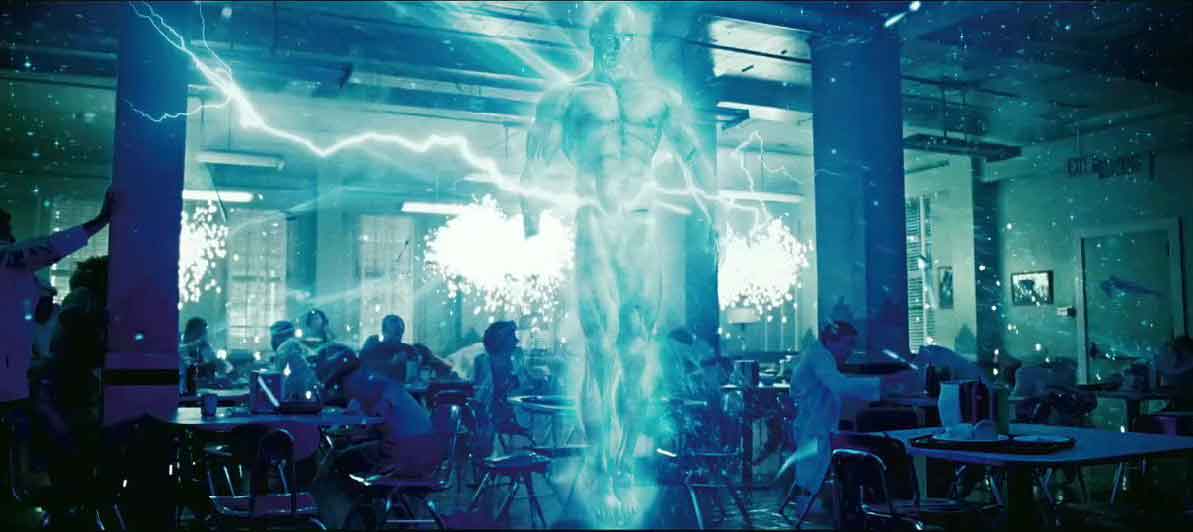
Grasp of Thanos.

Haunting the Web Since 1999

I guess he’s just a lonely spaceman: In the trailer bin of late, Sam Rockwell may or may not be going mad at the end of a three-year lunar stint in the trailer for Duncan Jones’ intriguing throwback to seventies sci-fi, Moon. (Jones, by the way, happens to be the son of Major Tom himself, David Bowie. Is he freaking you out, Bret?)
If not, the always-striking Charlotte Gainsbourg grapples with Rosemary’s Baby-like visions and possible demonic visitations in this disturbing (and slightly NSFW) preview for Lars von Trier’s Anti-Christ. Taken together, these beg the question: What seems like a worse idea — trusting an artificial intelligence that sounds like Kevin Spacey or venturing deep into the woods alone with Willem DaFoe?
“‘There is ‘something new and interesting going on in the universe,’ said Alan Kogut of NASA’s Goddard Space Flight Center in Greenbelt, Md.” Aspiring Jor-Els: Best get to work on those interstellar child-bearing rockets. Scientists detect a distant — and very loud — roar on the other side of the universe. “‘The universe really threw us a curve,’ Kogut said. ‘Instead of the faint signal we hoped to find, here was this booming noise six times louder than anyone had predicted.’” (Sssh, listen…there went Earth-2.)
“‘An automated rendezvous does all sorts of things for your missile accuracy and anti-satellite programs,’ said John Sheldon, a visiting professor of advanced air and space studies at Maxwell Air Force Base in Alabama. ‘The manned effort is about prestige, but it’s also a good way of testing technologies that have defense applications.‘” In order to keep pace with the increasingly proficient Chinese space program, President-elect Obama may be considering retying NASA to the Pentagon, “because military rockets may be cheaper and ready sooner than the space agency’s planned launch vehicle, which isn’t slated to fly until 2015…Obama has said the Pentagon’s space program — which spent about $22 billion in fiscal year 2008, almost a third more than NASA’s budget — could be tapped to speed the civilian agency toward its goals as the recession pressures federal spending.”
Hmm. On one hand, I would think making NASA yet another fiefdom of the Pentagon would greatly facilitate its ability to lock down the funding it needs for various exploratory endeavors, recession or no. And if the types of conveyance vehicles NASA needs are basically sitting around gathering dust in some Pentagon-owned warehouse next to the ark of the covenant, well then it only makes sense to combine the two programs. No need to reinvent the, uh, rocket.
On the other hand, putting the brass in charge is probably going to have deleterious effects on the types of projects NASA pursues in the future. And, in a perfect world, there’s something to be said for having a civilian space program completely outside the purview of the military. In fact, now that i think about it, won’t combining the Pentagon and NASA space programs cut back on the types of international cooperation that have guided our efforts in space in recent years? Given the current economic climate, I guess this is the best way for NASA to continue pursuing its goals in the short term. Still, there could well be trouble ahead.
“‘We’ve discovered this incredible dark energy, we don’t understand what the hell it is,’ said Lawrence Krauss, a physicist at Arizona State University. ‘It’s extremely small, extremely weak, and it’s so close to being zero, it’s just a total mystery why it should have this small value and not be zero.” While they’re still not entirely sure what in fact they’re looking at, Harvard-Smithsonian astrophysicists announce they’ve found another way to measure and quantify “dark energy”, a.k.a. the repulsive “cosmological constant” force causing the universe to expand rather than contract. “This is a much-needed confirmation that the earlier work was correct, the astronomers said, comparing it to football referees examining a controversial play with multiple camera angles.“
As an added bonus, the results announced today also seem to confirm Einstein’s general theory of relativity. “‘It’s never been proved right on the scale of the observable universe,’ Spergel said.”

And, if that wasn’t heady enough news to wrap one’s mind around, see also this article on loop quantum cosmology (LQC) and “The Big Bounce.” “LQC has been tantalising physicists since 2003 with the idea that our universe could conceivably have emerged from the collapse of a previous universe. Now the theory is poised to make predictions we can actually test. If they are verified, the big bang will give way to a big bounce and we will finally know the quantum structure of space-time. Instead of a universe that emerged from a point of infinite density, we will have one that recycles, possibly through an eternal series of expansions and contractions, with no beginning and no end.” (Both links via Dangerous Meta.)
“Said John Logsdon, a George Washington University professor who co-wrote the book honored at the NASA party, ‘There is a natural tension built into this situation… Mike is dead-on convinced that the current approach to the program is the right one. And Lori’s job is to question that for Mr. Obama. The Obama team is not going to walk in and take Mike’s word for it.'” The Orlando Sentinel suggests that NASA head Michael Griffin isn’t being particularly helpful to the transition team at the agency: “NASA administrator Mike Griffin is not cooperating with President-elect Barack Obama’s transition team, is obstructing its efforts to get information and has told its leader that she is ‘not qualified’ to judge his rocket program, the Orlando Sentinel has learned.“
I’ve been quite complimentary of Mike Griffin here in the past. He seems like a smart, take-no-guff fellow, and I’m in general agreement with his views on space exploration. But this sort of tantrum reflects poorly on him. Knowing nothing other than what’s written in this article, it sounds like Griffin, a holder of six advanced degrees, is indulging his engineer’s exasperation with the laypersons who seem to be meddling with his current experiment. But if Griffin wants to see the vision he’s outlined for NASA make it into the next administration, I suspect honey would garner more flies than vinegar at this moment.

“The last Twitter post said it all: “01010100 01110010 01101001 01110101 01101101 01110000 01101000.”” Or, in other words, Ground Control to Phoenix Lander: You’ve really made the grade. Having seemingly succumbed to the Martian winter at last, the Mars Phoenix Lander is pronounced deceased by NASA. “NASA official Doug McCuistion counseled people to view Phoenix’s end as ‘an Irish wake rather than a funeral. It’s certainly been a grand adventure.’…While some followers said farewell to Phoenix in computer language today, others kept it simple. ‘Good bye Phoenix, I love you :(,’ said user patach.“

“It’s really a generation that we’ve been looking forward to this moment, and the moments that will come after it in particular. September 10 is a demarcation between finishing the construction and starting to turn it on, but the excitement will only continue to grow.” A Quantum Leap Forward, or the End of Days? (Answer: The former.) Over on the border of France and Switzerland, the Large Hadron Collider — the giant, multi-billion-dollar particle accelerator decades in the making — gets ready for its first big test on Wednesday (as does its accompanying “Grid”.) “The collider will recreate the conditions of less than a millionth of a second after the Big Bang, when there was a hot ‘soup’ of tiny particles called quarks and gluons, to look at how the universe evolved, said John Harris, U.S. coordinator for ALICE, a detector specialized to analyze that question.“
Europa, Enceladus…Titan? The ESA’s Cassini-Huygens probe discovers a liquid lake on Saturn’s largest moon, although it’s definitely not water. ““Detection of liquid ethane in Ontario Lacus confirms a long-held idea that lakes and seas filled with methane and ethane exist on Titan.” [Via Quiddity.]